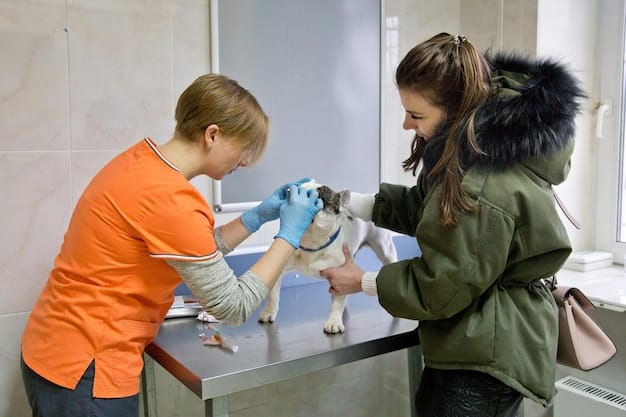Is Your Pet’s Food Making Them Sick? Spotting Allergens in 2025

Is your pet experiencing unexplained health issues? Hidden allergens in their food could be the culprit; our guide helps you identify these potential triggers in 2025 to ensure your furry friend’s well-being.
Could your beloved pet’s food be the silent enemy behind their persistent health problems? In 2025, with evolving food formulations and manufacturing processes, identifying hidden allergens in pet food is more critical than ever. This guide, **Is Your Pet’s Food Making Them Sick? Spotting Hidden Allergens in 2025**, will equip you with the knowledge to recognize and address potential food sensitivities in your furry companion.
Unmasking Pet Food Allergies in 2025
Pet food allergies are a growing concern, often manifesting in various uncomfortable symptoms. Recognizing these signs early can significantly improve your pet’s quality of life. Let’s delve into the common indicators of food allergies in pets and how they might present in 2025.
Common Allergy Symptoms
Allergies in pets can range from mild skin irritation to severe gastrointestinal distress. Here’s what to look for:
- Itchy Skin: Persistent scratching, licking, or chewing, especially around the paws, face, and ears.
- Digestive Issues: Vomiting, diarrhea, or changes in stool consistency often indicate food sensitivities.
- Hair Loss: Thinning fur or bald patches, particularly in areas that your pet excessively scratches or licks.
- Ear Infections: Recurring ear infections can be a sign of underlying allergies.
While these symptoms are common, it’s important to distinguish them from other conditions. Consulting with your veterinarian is crucial for an accurate diagnosis.
Decoding Pet Food Labels for Allergy Triggers
Understanding pet food labels is essential for identifying potential allergens. Labels can be confusing, but knowing what to look for can make a difference. Let’s break down how to read pet food labels and spot common allergy-inducing ingredients.
Carefully examining the ingredient list is the first step. Look for ingredients known to cause allergic reactions in pets, such as:
- Common Proteins: Beef, chicken, and dairy are frequent offenders.
- Grains: Wheat, corn, and soy can be problematic for some pets.
- Additives: Artificial colors, flavors, and preservatives can trigger allergic reactions.
Also, be aware of “hidden ingredients,” which may not be explicitly listed but are present in the food. This includes ingredients in “meal” or “by-product” listings.

Hidden Food Allergens: What to Watch Out For
Even with diligent label reading, some allergens remain hidden. These can be unintentional contaminants or ingredients listed under vague terms. Let’s uncover these concealed allergens and how to avoid them.
Hidden allergens can be challenging to identify. Here are some to keep an eye on:
- Cross-Contamination: Manufacturing facilities may process multiple types of pet food, leading to cross-contamination with allergens.
- Vague Ingredients: Terms like “natural flavoring” or “animal digest” can mask potential allergens.
- Ingredient Splitting: Manufacturers may split ingredients into smaller portions to make them appear less prevalent on the label.
To mitigate these risks, opt for brands that prioritize allergen control and transparency in their labeling practices.
The Rise of Novel Protein Diets: A Solution?
Novel protein diets, featuring uncommon protein sources, are gaining popularity as a way to manage food allergies. But are they a foolproof solution? Let’s assess the benefits and limitations of these specialized diets.
What Are Novel Proteins?
Novel proteins are ingredients that your pet has likely not been exposed to before, reducing the risk of allergic reaction. Common examples include:
- Kangaroo: A lean and novel protein source often well-tolerated by allergic pets.
- Venison: Another lean protein that is less likely to cause allergic reactions.
- Duck: A palatable poultry alternative for pets allergic to chicken.
While novel protein diets can be effective, it’s essential to introduce them under veterinary guidance to ensure they meet your pet’s nutritional needs.
Diagnostic Testing: Pinpointing the Culprit
When dietary changes aren’t enough, diagnostic testing can provide clarity. Various tests can help identify specific allergens affecting your pet. Let’s explore the types of tests available and their reliability.
Common Allergy Tests for Pets
Several tests can help determine what your pet is allergic to:
- Food Elimination Trial: The gold standard for diagnosing food allergies. It involves feeding your pet a restricted diet for several weeks and then reintroducing ingredients one at a time.
- Serum Allergy Testing: A blood test that measures IgE antibodies to specific allergens. While convenient, the accuracy can vary.
- Intradermal Skin Testing: Involves injecting small amounts of allergens under the skin to observe reactions. Generally more accurate than serum testing.
Consult with your veterinarian to determine the most appropriate testing method for your pet.

The Future of Allergen-Free Pet Food in 2025
As we move into 2025, advancements in pet food manufacturing and ingredient sourcing promise more allergen-free options. Let’s explore the innovations on the horizon and what they mean for allergy-prone pets.
Emerging Trends
Several trends are shaping the future of allergen-free pet food:
- Hydrolyzed Proteins: Proteins broken down into smaller fragments, making them less likely to trigger allergic reactions.
- Sustainable Ingredients: Insect-based proteins and plant-based alternatives offer novel and environmentally friendly options.
- Precision Nutrition: Personalized diets tailored to your pet’s specific needs and sensitivities.
With these advancements, managing pet food allergies will become more precise and effective.
Working with Your Veterinarian for Allergy Management
Managing pet food allergies effectively requires a collaborative approach with your veterinarian. Professional guidance ensures your pet receives the right diagnosis, treatment, and ongoing support. Let’s understand the key roles of veterinary professionals in allergy management.
Your veterinarian plays a crucial role in:
- Diagnosis: Performing necessary tests and ruling out other potential health issues.
- Treatment Planning: Developing a customized diet plan and managing symptoms.
- Ongoing Monitoring: Adjusting the treatment as needed and ensuring your pet’s overall well-being.
Regular check-ups and open communication with your vet are essential for long-term allergy management.
| Key Point | Brief Description |
|---|---|
| 🔍 Spotting Symptoms | Look for itching, digestive issues, and hair loss. |
| 📜 Read Labels | Identify common allergens like beef, chicken, or grains. |
| 🌱 Novel Proteins | Consider diets with kangaroo, venison, or duck. |
| 🧪 Diagnostic Tests | Use elimination trials or allergy tests for diagnosis. |
Frequently Asked Questions
▼
Common allergens include beef, chicken, dairy, wheat, corn, and soy. These ingredients are frequently used in pet food and can trigger allergic reactions in susceptible animals.
▼
Improvement typically takes 4-12 weeks. The pet should only eat the new food and water during the trial. The trial should be performed under the guidance of a vet.
▼
Not necessarily. Grain-free diets might help if your pet is allergic to specific grains, but they are not inherently superior. Allergies vary, and some pets might be allergic to other ingredients in grain-free foods.
▼
Yes, environmental allergies can cause similar symptoms such as itching and skin irritation. It’s essential to differentiate between the two through veterinary testing and elimination trials to manage them effectively.
▼
At-home allergy test kits for pets are generally less reliable than those performed by a veterinarian. They can produce false positives and negatives, leading to inaccurate treatment plans. Always consult with a vet for accurate testing.
Conclusion
Navigating pet food allergies in 2025 requires vigilance, knowledge, and collaboration with your veterinarian. By understanding the symptoms, scrutinizing food labels, and exploring innovative dietary options, you can ensure your pet’s health and happiness, free from the discomfort of hidden allergens.





